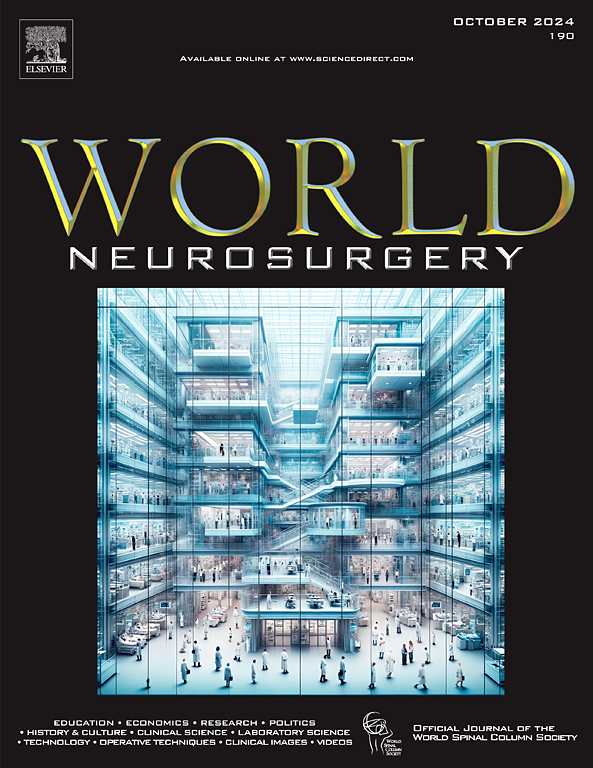单侧和双侧PVP治疗胸腰椎OVCF伴远端腰骶疼痛:单中心回顾性分析。
IF 1.9
4区 医学
Q3 CLINICAL NEUROLOGY
引用次数: 0
摘要
背景:既往研究发现,无论是单侧穿刺还是双侧穿刺,经皮椎体成形术(percutaneous vertebroplasty, PVP)均能有效改善胸腰椎骨质疏松性椎体压缩性骨折(OVCF)引起的患椎体局部疼痛,但对于伴随的远端腰骶疼痛是否同样有效,鲜有报道。目的:分析单侧或双侧PVP治疗胸腰椎OVCF伴远端腰骶疼痛的临床效果。方法:回顾性分析2019年3月至2023年3月我院单期OVCF患者PVP治疗的临床资料。根据术中穿刺方式的不同,将全队列患者分为单侧穿刺组(52例)和双侧穿刺组(40例)。术前、术后和最终随访分别采用视觉模拟评分(VAS)评估骨折椎体局部疼痛程度和远端腰骶疼痛程度。采用Oswestry功能障碍指数(ODI)评价功能障碍。在最后一次随访时,评估在这些措施中达到最小临床重要差异和可接受症状状态的患者比例。结果:92例患者平均随访时间为(20.1±7.6)个月,术后第3天及末次随访时局部疼痛、腰骶疼痛VAS评分及ODI指数较术前均有显著改善,差异有统计学意义(P < 0.05),但术后第3天上述指标与末次随访时差异无统计学意义(P < 0.05)。术后不同时间点单侧穿刺组与双侧穿刺组局部疼痛、腰骶疼痛VAS评分、ODI评分比较,差异均无统计学意义(P < 0.05)。末次随访时,两组患者局部疼痛最小临床意义、腰骶疼痛VAS评分、ODI指数及症状状态达到可接受率比较,差异均无统计学意义(P < 0.05)。结论:PVP不仅可以改善OVCF胸腰段责任椎的局部疼痛和ODI指数,还可以改善伴随的远端腰骶疼痛症状,穿刺入路不影响术后疼痛和功能的改善。本文章由计算机程序翻译,如有差异,请以英文原文为准。
Unilateral and Bilateral Percutaneous Vertebroplasty for Thoracolumbar Osteoporotic Vertebral Compression Fracture with Distant Lumbosacral Pain: A Single-Center Retrospective Analysis
Background
Previous studies have found that percutaneous vertebroplasty (PVP) can effectively improve the local pain (LP) of the affected vertebra caused by thoracolumbar osteoporotic vertebral compression fracture (OVCF) regardless of unilateral or bilateral puncture, but there are few reports on whether it is equally effective for the accompanying distant lumbosacral pain. The objective of this study was to analyze the clinical efficacy of unilateral or bilateral PVP in the treatment of thoracolumbar OVCF with distant lumbosacral pain.
Methods
The clinical data of patients with single-stage OVCF treated with PVP in our hospital from March 2019 to March 2023 were retrospectively analyzed. According to different intraoperative puncture methods, the whole cohort of patients was divided into unilateral puncture group (52 cases) and bilateral puncture group (40 cases). Preoperative, postoperative, and final follow-up were evaluated using a visual analogue scale (VAS) to assess the degree of LP in the fractured vertebrae and distant lumbosacral pain, respectively. The Oswestry Disability Index (ODI) was used to evaluate functional impairment. At the last follow-up, the proportion of patients who achieved the minimum clinical importance difference and acceptable symptom status on these measures was evaluated.
Results
The average follow-up time of the 92 patients was 20.1 ± 7.6 months, and the LP, lumbosacral pain VAS score and ODI index at 3 days after surgery, and the last follow-up were significantly improved compared with those before surgery, with statistical differences (P < 0.05), but there was no statistical difference between the above indexes at 3 days after surgery and the last follow-up (P > 0.05). There were no significant differences in LP, lumbosacral pain VAS scores and ODI scores between unilateral puncture group and bilateral puncture group at different time points after surgery (P > 0.05). At the last follow-up, there were no statistically significant differences in the minimum clinical significance of LP, lumbosacral pain VAS score and ODI index and the rate of patients achieving acceptable symptom status between the two groups (P > 0.05).
Conclusions
PVP can not only improve the LP and ODI index of the responsible vertebra of OVCF in the thoracolumbar region, but also improve the accompanying distant lumbosacral pain symptoms, and the puncture approach does not affect the improvement of postoperative pain and function.
求助全文
通过发布文献求助,成功后即可免费获取论文全文。
去求助
来源期刊

World neurosurgery
CLINICAL NEUROLOGY-SURGERY
CiteScore
3.90
自引率
15.00%
发文量
1765
审稿时长
47 days
期刊介绍:
World Neurosurgery has an open access mirror journal World Neurosurgery: X, sharing the same aims and scope, editorial team, submission system and rigorous peer review.
The journal''s mission is to:
-To provide a first-class international forum and a 2-way conduit for dialogue that is relevant to neurosurgeons and providers who care for neurosurgery patients. The categories of the exchanged information include clinical and basic science, as well as global information that provide social, political, educational, economic, cultural or societal insights and knowledge that are of significance and relevance to worldwide neurosurgery patient care.
-To act as a primary intellectual catalyst for the stimulation of creativity, the creation of new knowledge, and the enhancement of quality neurosurgical care worldwide.
-To provide a forum for communication that enriches the lives of all neurosurgeons and their colleagues; and, in so doing, enriches the lives of their patients.
Topics to be addressed in World Neurosurgery include: EDUCATION, ECONOMICS, RESEARCH, POLITICS, HISTORY, CULTURE, CLINICAL SCIENCE, LABORATORY SCIENCE, TECHNOLOGY, OPERATIVE TECHNIQUES, CLINICAL IMAGES, VIDEOS
 求助内容:
求助内容: 应助结果提醒方式:
应助结果提醒方式:


